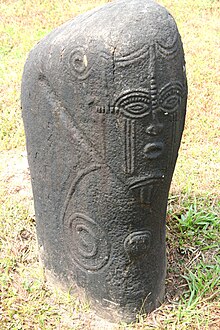Ikom monoliths

The Ikom monoliths are a series of volcanic-stone monoliths from the area of Ikom, Cross River State, Nigeria. The Ejagham may have engraved the monoliths around 200 CE. The monoliths are also called Akwasnshi or Atal among the Ejagham people.[1][2]
Description
[edit]The stones are distributed among over thirty communities, in each community, they are found in circles, facing each other erect. Numbering about 300 in total, the monoliths are between 0.3 and 1.8 metres (1 and 6 feet) high and are laid out in some thirty circles located around Alok in the Ikom area of Cross River State. They may be located in the central meeting place of the village or in the uncultivated area outside the village. The monoliths are carved in hard, medium-textured basaltic rock, a few are carved in sandstone and shelly limestone; they are phallic in form and some feature stylized faces as well as decorative patterns and inscriptions. Although the carvings have not been deciphered, researchers and linguists believe that the inscriptions may represent a form of writing and visual communication.[2][3]
Conservation risk
[edit]This section needs to be updated. (January 2023) |
Exposure to extreme weather conditions have put these monoliths at risk of erosion and deterioration. The monoliths are also located in an area where the nearby people do not commonly see their worth as tourist attractions. They were added to the World Monuments Fund's list of sites in danger in 2008.[4] In 2020, Ikom monoliths were found by U.S Customs and Border Protection at Miami International Airport under fraudulent documents. The artifacts will be returned to Cross River (Nigeria).[5]
Museum collections
[edit]A medium-sized example of an Ikom monolith with human facial features can be found in the British Museum's collection.[6]
References
[edit]- ^ Onor, Sandy (2015). "Chronology and Oral Historical Reconstruction: The Example of the Ejagham of the Cross River Region of Nigeria". Journal of the Historical Society of Nigeria. 24: 37–55. ISSN 0018-2540. JSTOR 24768928. Retrieved 17 July 2023.
- ^ a b "Alok Ikom Stone Monoliths - UNESCO World Heritage Centre". whc.unesco.org. Retrieved 31 August 2024.
- ^ "Ikom Monoliths of Cross River State | World Monuments Fund". www.wmf.org.
- ^ "Ikom Monoliths of Cross River State". World Monuments Fund. Retrieved 20 February 2019.
- ^ Nomishan, Terngu Sylvanus; Tubi, Paul-Kolade; Gubam, Dimas Solomon (2023-11-23). "Cultural heritage management and the effect of corruption in Nigeria: hampering sustainable development via cultural heritage destruction". Journal of Cultural Heritage Management and Sustainable Development. 13 (4): 662–684. doi:10.1108/JCHMSD-12-2020-0175. ISSN 2044-1266.
- ^ "figure". British Museum.

